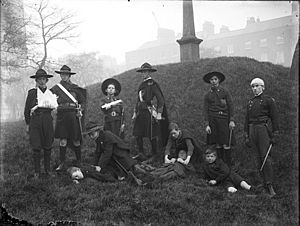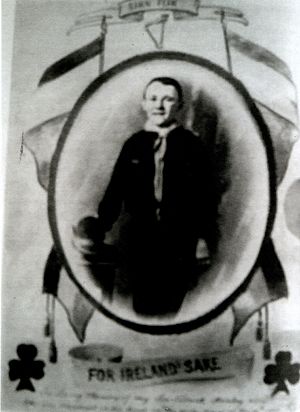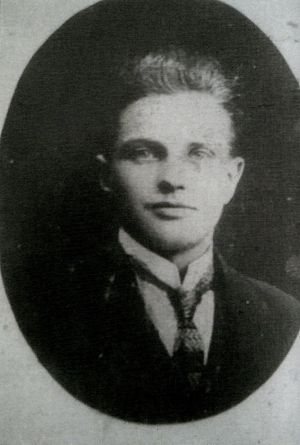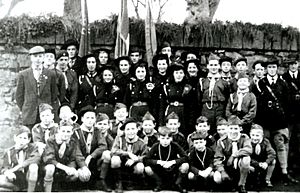Fianna Éireann facts for kids
Quick facts for kids Fianna Éireann |
|
|---|---|
| Participant in Irish War of Independence Irish Civil War |
|
 |
|
| Active | 16 August 1909 - Present |
| Ideology | Irish republicanism Irish nationalism |
| Founder | Constance Markievicz |
| Headquarters | Dublin |
| Area of operations | Republic of Ireland Northern Ireland |
| Allies | Republican Sinn Féin (1986–present) Cumann na mBan (1914–present) Continuity Irish Republican Army (1986–present) |
| Website | nafiannaeireann.wordpress.com |
| Designated as a terrorist organisation by | |
Na Fianna Éireann (which means "The Fianna of Ireland") is an Irish nationalist youth group. It was started by Constance Markievicz in 1909, with help from Bulmer Hobson. The group was also known simply as the Fianna.
Fianna members helped create the Irish Volunteers. They also had their own secret group within the Irish Republican Brotherhood (IRB). They were involved in bringing guns into Ireland in 1914, known as the Howth gun-running. Many Fianna members also fought in the 1916 Easter Rising. They were very active during the War of Independence. Later, many chose the anti-Treaty side in the Civil War.
The government of the Irish Free State made the Fianna an illegal group in 1931. This rule was changed in 1932 but brought back in 1938. In later years, the Fianna supported different political groups. They supported Provisional Sinn Féin in 1969 and Republican Sinn Féin in 1986. The Fianna has been a banned group in Northern Ireland since 1920.
Contents
How Na Fianna Éireann Started
An earlier group called "Fianna" was formed in 1902 in Belfast. It aimed to promote hurling and the Irish language. This idea came from Bulmer Hobson. Hobson later moved to Dublin, and the Belfast Fianna group ended.
Constance Markievicz was inspired by the fast growth of the Boy Scouts. Before July 1909, she started a group in Dublin called the Red Branch Knights. After talking with Hobson and others, this group changed its name to Na Fianna Éireann. This happened at a meeting in Dublin on August 16, 1909. Hobson became the president, and Markievicz became the vice-president.
The Fianna was created as an alternative to Baden-Powell's Boy Scouts. Its main goal was to help Ireland become fully independent. They did this by teaching scouting, military exercises, Irish history, and the Irish language. Important leaders in Dublin included Seán Heuston and Cornelius "Con" Colbert.
Early Years and Training
In 1913, the Fianna published a training handbook. It included articles by famous figures like Patrick Pearse and Roger Casement. This book was also widely used by the Irish Volunteers, who were formed around the same time.
Countess Markievicz bought a large house in Ranelagh, Dublin. This house became an unofficial headquarters for the Fianna. Older boys would train there, and they even had a small firing range in the basement. They also had a radio, which led to a police raid. Later, a separate main office was set up in D'Olier Street.
The Irish Republican Brotherhood (IRB) wanted to recruit Fianna members who were 17 or older. In 1912, Hobson started a special IRB group within the Fianna. Its members included Colbert, Heuston, and Liam Mellows.
Working with the Irish Volunteers
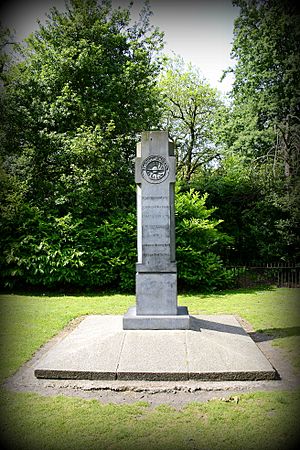
The Fianna played an active role during the 1913 Dublin lock-out, a big workers' strike. A Fianna member, Patsy O'Connor, died after being hit by a policeman while helping an injured man.
The Fianna group was formed four years before the Irish Volunteers. Many of its members were already trained in military skills. Because of this, many young Fianna members joined the Volunteers when that group was founded in November 1913. Three Fianna members were on the committee that set up the Irish Volunteers. Con Colbert and others were important in training the new Volunteers.
Bringing Guns to Howth in 1914
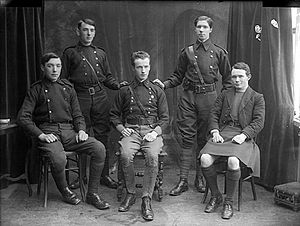
The Fianna helped bring guns ashore at Howth and Kilcoole. Fianna members used their carts to meet the Asgard boat at Howth Pier. They brought homemade batons for the Volunteers. After the guns were unloaded, the carts were used to carry extra rifles back to Dublin.
Police and British soldiers tried to stop the Volunteers at Clontarf. But Fianna officers took their gun-filled cart on a different route. They stored the weapons safely for later use.
The Easter Rising in 1916
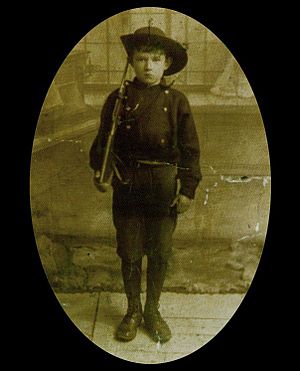
Fianna members fired some of the first shots of the 1916 Rising. They attacked and captured the Magazine Fort in the Phoenix Park. A son of the fort's commander was shot and killed by a Fianna member as he tried to warn others.
Fianna members fought in all the main areas during the Easter Rising. Even though they were part of the Irish Volunteers by then, Seán Heuston and Con Colbert were still seen as Fianna members. Heuston led the group at the Mendicity Institution. Colbert was with Éamonn Ceannt at Watkins Brewery. Both Heuston and Colbert were executed for their part in the Rising.
Constance Markievicz fought with the Irish Citizen Army. She was sentenced to death but her sentence was changed. She stayed in prison longer than almost anyone else involved.
In Galway, Liam Mellows led activities. He escaped capture and went to the United States to get help for the War of Independence. (Mellows later returned and was executed during the Irish Civil War.)
After the main rebel post office was abandoned, James Connolly gave command to Seán McLoughlin, a Fianna officer. His job was to make sure everyone else got away safely.
Several Fianna members died during the Rising. Seán Healy was shot while delivering messages. Seán Howard and Seán Ryan also died in similar ways. Fianna officers also captured and burned down the Linenhall Barracks. Many Fianna officers were sent to a prison camp in Wales after the Rising.
Rebuilding After 1916
The Fianna was one of the first groups to reorganize after the 1916 Easter Rising. A temporary committee was set up in Dublin in May 1916. Its members included Eamon Martin and others who had avoided being captured. This committee led the group until early 1917.
In February 1917, a group of Fianna members marched in uniform to a church service. This was to remember Michael Mallin, who had been executed after the Rising. The police did not stop them, which made the Fianna members more confident.
A year after the Rising, a large protest was held. Police tried to break it up and arrest leaders like Cathal Brugha. During this, a police inspector was hit and killed. Fianna witnesses said a young Fianna officer, Eamon Murray, struck the blow. Murray escaped and was helped by Constance Markievicz to get to the United States. He later fought in the Civil War.
The Fianna started a big recruitment drive in Dublin in 1917. Many new members joined, and new groups were formed. The Dublin Fianna became so large that it was split into two battalions.
The Fianna continued to march and drill openly, even though the British had banned it. This often led to clashes with the police. In July 1917, the entire Dublin Battalion marched through the city and county. Police tried to stop them but failed.
Agreement with the Irish Volunteers
Around 1918, the Irish Volunteers were trying to control Fianna groups in some areas. A meeting was held between Fianna and Volunteer leaders to fix this. They created an "Army Agreement." This agreement stated that the Volunteers would no longer try to control the Fianna. Also, Fianna members would only join the Volunteers if they wanted to, not automatically when they turned 17.
The War of Independence
During the "Tan War", Fianna members were very active in many areas. Some lost their lives or were put in prison. In one photo of a fighting unit from 1921, ten out of thirty members had been part of the Westport Fianna.
During the truce in 1921, the Fianna spent a lot of time training. They set up several training camps for future officers. At a big meeting in 1921, it was reported that the Fianna had many branches across Ireland. The Fianna discussed the Anglo-Irish Treaty and decided to reject it. They called for all members to keep working for an independent Republic.
The Irish Civil War
Fianna Éireann played a big part in the Civil War fighting, especially in Dublin. When the Four Courts building was attacked in July 1922, the Fianna helped create a second front to try and relieve it. They took over and barricaded buildings on O'Connell Street and Parnell Street.
In August 1922, the Fianna suffered a big loss. Two of their senior officers in Dublin, Seán Cole and Alf Colley, were shot and killed by Free State Army members.
About 400 Fianna officers and boys fought in Dublin in 1922. By October, only a small active group of eight members remained.
The bodies of three teenage Fianna Scouts, Edwin Hughes (17), Joseph Rogers (16), and Brendan Holohan (16), were found in November 1922. They had been putting up republican posters and were arrested. They were last seen alive at Wellington Barracks.
When the Free State government started executing republican prisoners, the first four to be shot had left the Fianna to join the Irish Republican Army. These four, Rory O'Connor, Joe McKelvey, Liam Mellows, and Dick Barrett, became known as "The Four Martyrs" for the Fianna.
By Christmas 1922, the Fianna stopped working as an open group. Many senior Fianna members were arrested and sent to prison camps. Some were as young as fourteen.
Fianna After the Civil War
The Fianna group was greatly weakened after the Civil War. It faced more challenges in 1926 when Fianna Fáil was founded. Constance Markievicz, a founder of Fianna Éireann, also helped start Fianna Fáil. She died in 1927 after years of imprisonment had affected her health.
In 1930, the Fianna started using the Hardwicke Hall in Dublin as its headquarters. George Plunkett was named Chief Scout. The group grew bigger around this time. In 1934, a report said there were 104 Fianna branches.
The Free State government passed new laws in 1931. These laws made the Fianna, the IRA, and Cumann na mBan illegal groups. Many members were arrested, and the groups had to go underground. When the Fianna Fáil government came to power in 1932, they removed these laws. Many prisoners were freed, and some young republicans joined Fianna Fáil.
In 1936, the Fianna was outlawed again. In 1938, a group of important republicans was set up to help reorganize the Fianna. This group included George Plunkett and Mary MacSwiney. The next year, Joe Atkinson helped set up new Fianna branches across the country. In 1940, 150 Fianna members marched in Dublin.
By 1943, due to arrests and people leaving the country, the Fianna in Dublin was reduced to just one branch. After the war, new leaders helped reorganize the group. By 1947, Dublin had a new leader, Des Carron. The first annual camp of the new group was held in 1947.
Fianna Organization After 1950
After World War II, some older Fianna members joined the Irish Army as a special battalion. This battalion flew both the Fianna and Irish Army flags. In 1953, the older Fianna group offered their flag to the current Fianna. But the current Fianna leaders refused because the handover was planned for a military barracks. The old Fianna group eventually faded away.
In 1951, a meeting reported that there were 9 Fianna branches. Dick Bell was re-elected as Chief Scout. In 1953, Ned Kelly became Chief Scout. He gathered young leaders and started four new branches in Dublin.
In 1954-1955, a split happened in the republican movement. Some activists wanted more armed action in Northern Ireland. A breakaway group also called themselves Fianna Éireann. A serious clash happened between the two groups in 1959 over selling the Easter Lily badge.
Ned Kelly was removed as Chief Scout in 1955. George Darle took his place. He brought new energy to the group, and new branches were formed in other towns. The IRA's Border Campaign, which started in 1956, caused the Fianna to lose many members.
Uniform Changes Around 1958
The Fianna uniform in 1958 was similar to its original 1909 design. It included a green shirt, an orange neckerchief, and a slouch hat. Officers wore riding breeches and a military jacket. The uniform was then changed to look more like an American Boy Scout uniform. It featured a green shirt with two pockets and a military-style side hat. Later, green berets replaced the side hats.
Jubilee Camp in 1959
In 1958, a committee was formed to celebrate the Fianna's 50th anniversary. They decided to hold a camp in central Ireland in August 1959. About 100 Fianna members attended. The police visited the homes of young Scouts during the camp. They told parents that their boys were at an IRA training camp. This caused some members to leave the group.
In 1959, the Fianna was given the honor of leading the annual pilgrimage to the grave of Wolfe Tone at Bodenstown. A report in 1963 showed that new Fianna units were formed in other towns. A new section was also created for friends of the Fianna who were too old to join.
Younger Members
The Fianna had always been for boys aged 11 to 16. Around 1959, a new idea was introduced to include younger boys. With help from some Cumann na mBan members, boys as young as eight were allowed to join. They wore a plain green sweater and a yellow neckerchief. This idea was successful, and most branches followed it.
New Fianna Handbook
Around 1963, a committee was formed to raise money for a new Fianna handbook. This was the third edition of the handbook. The previous ones were printed in 1913 and 1924. The new handbook was published around 1965.
Activities of the Fianna
The 1950s and 1960s were very busy years for Fianna members. Branches usually met once a week in full uniform. They practiced scouting skills, played games, and planned hikes or camps for the weekend. Fianna members often went hiking in the Dublin/Wicklow mountains, even in bad weather. This was a time when a lot of military camping gear became available after the Korean War.
Another popular weekend activity was staying in old, deserted houses in the mountains, called "shacks." All-night hikes were also popular with officers. They would take the last bus out of town and then march all night across the hills. Youth hostels were also popular with younger Scouts. Many Dublin branches organized camps during holidays and week-long annual camps.
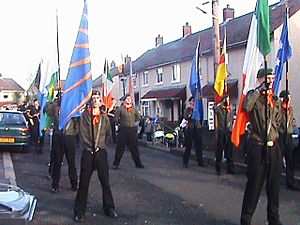
Republican events were held regularly, and the Fianna was expected to attend in full uniform. The annual Easter Commemoration was usually the first event. The parade would march from St. Stephen's Green to Glasnevin Cemetery. The Wolfe Tone Commemoration was another big event, often held in June. Trains and buses would bring people from all over the country.
The Fianna also held many protests against imprisonment and unfair rules. They were very visible on the streets during these times. Selling the Easter Lily badge was a main way for the group to earn money. Sometimes, the police would take their boxes of badges because the Fianna did not apply for permits.
After 1969
Like the wider republican movement, the Fianna split into different groups after the start of the Troubles. In 1969, two groups claimed to be the real Fianna Éireann. One group was linked to the Official movement, and the other supported the Provisional Sinn Féin and IRA.
The Fianna group linked to the Officials was dissolved in 1976. It was replaced by the Irish Democratic Youth Movement. This happened after many Fianna members left to join another group in 1974.
In 1986, there was another split within the Provisional Sinn Féin and IRA. The Fianna then stopped supporting the Provisional movement. They said they were sticking to traditional republican beliefs. Now, the Fianna supports Republican Sinn Féin and the Continuity IRA. A report in 2015 said the group had about 30 members.
A 2020 study found four main reasons why people joined the Fianna:
- Coming from a working-class background with social problems.
- Strong family links and social networks.
- Learning about republicanism through social media.
- Being very interested in Irish history.
Leaders of Na Fianna Éireann
- Eamon Martin (around 1917–1922)
- Pádraig Ó Riain (July 1915)
- Constance Markievicz (around 1923)
- Liam Langley (Langlaoich) (around 1929)
- Frank Ryan (around 1932)
- George Plunkett (around 1933)
- Tomás Óg Mac Curtain, Cork (around 1948–1950)
- Dick Bell, Dublin (around 1950–1952)
- Ned Kelly, Dublin (1952–1955)
- George Darle, Dublin (1955–1957)
- Pat Madden, Cork (1958)
- Jimmy Cruise, Dublin (1958–1960)
- Brian Murphy, Dublin (1960–1962)
- Uinsionn Ó Cathain (1962–1964)
- Seán Ó Cionnaith (temporary Chief Scout in late 1964)
- Liam Mac an Ultaigh (1965–19??)
See also
- Ógra Shinn Féin
- Urz Skaouted Bleimor
- Urdd Gobaith Cymru


